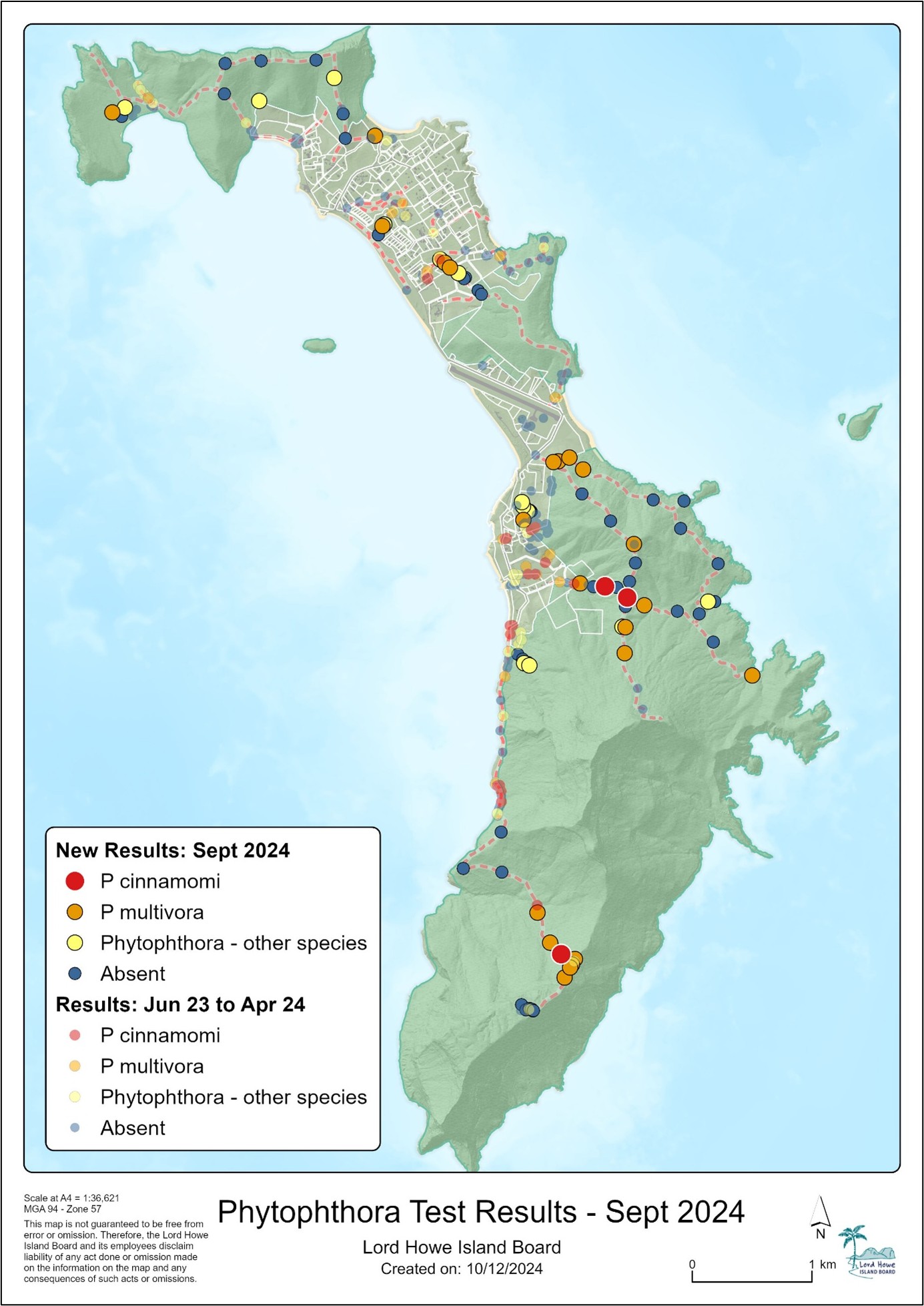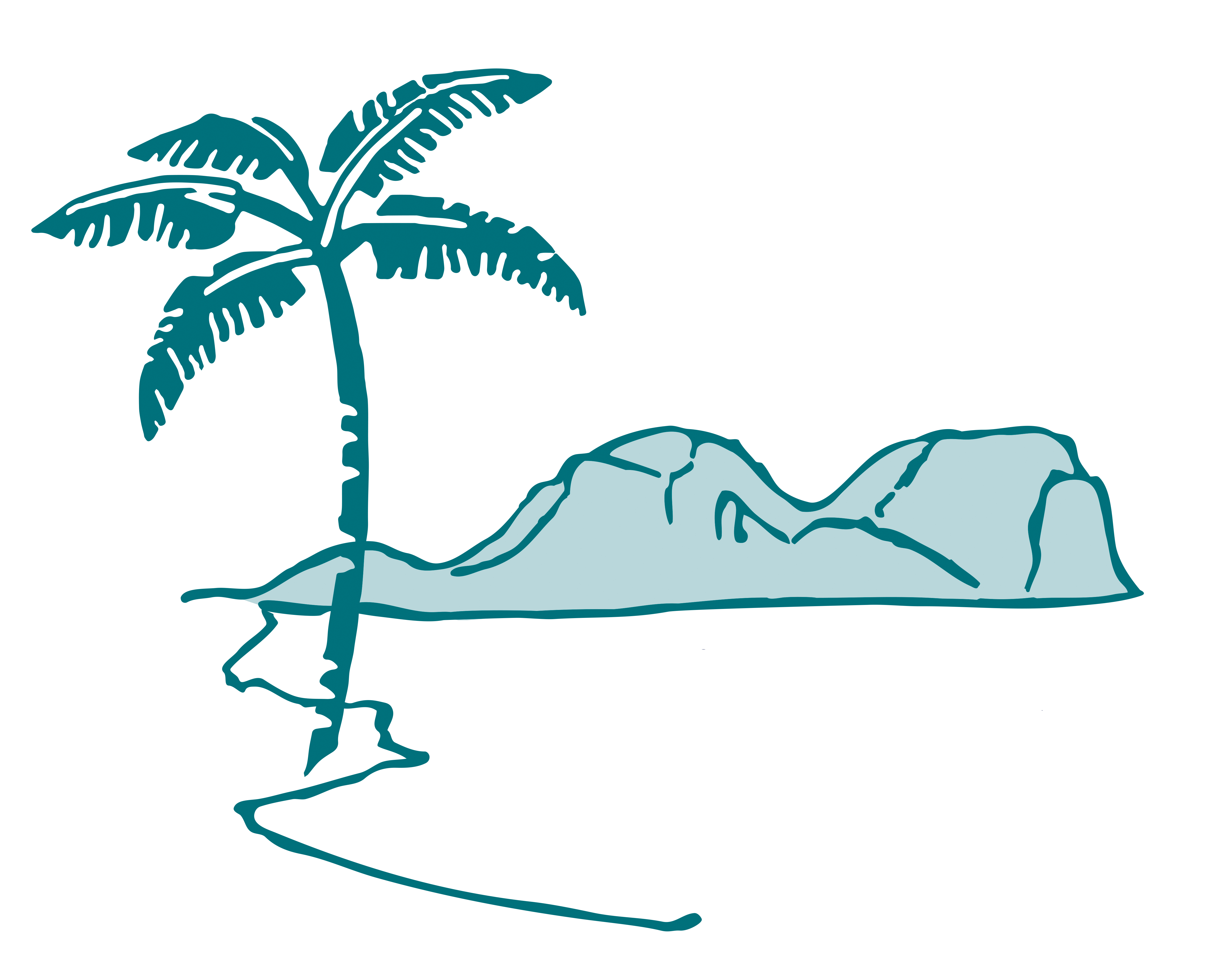Phytophthora update
In September, scientists from the Botanic Gardens of Sydney PlantClinic visited the Island for the second time since May 2023. Their primary aim was to gain a better understanding of the distribution of Phytophthora within the Permanent Park Preserve (PPP).
Results to date confirm that Phytophthora sp. is present in the PPP. The main species of concern Phytophthora cinnamomi was detected at three of the 91 sites, all beyond its previously known extent:
- Two sites on Smoking Tree Ridge track, east of previous detections.
- One site on the Mount Gower walking track, between Erskines Creek and The Saddle, beyond the previous known extent of Erskines Creek.
Another species of concern Phytophthora multivora was found at 25 of the 91 sites, including:
- Six sites on the Mount Gower walking track, between Erskines Creek and the Getup Place (all beyond previously detections).
- In the PPP at Boat Harbour, Intermediate Hill, and on Smoking Tree Ridge.
- Detections near the Settlement along Bowker Avenue and at Ned’s Beach.
- At North Bay close to the banana patch and the path to New Gulch.
Four additional Phytophthora species in addition to the nine previously found were also detected during this survey.
This was the most extensive sampling of the PPP to date, with 71 of the 91 samples collected along the walking track network. The remaining 20 samples were taken from targeted areas within the settlement. It follows visits from PlantClinic in April 2023, May 2024 and an interim sampling trip into the Permanent Park Preserve in June 2024.
Further samples have since been taken from the summit of Mt. Gower by snail researchers in October 2024. These samples are currently being analysed and will be published in the new year.
Plate 1. below illustrates the locations of the sample points across the island since June 2023.
Table 1. Is a summary of the Phytophthora species present on the island.
What is Phytophthora?
Phytophthora is a microscopic pathogen that lives in the soil and is known to cause disease in a broad range of plant species.
Phytophthora spreads naturally by moving through soil and the roots it infects, and in run-off. While animals are able to spread Phytophthora when infested soil gets caught in their feet and fur, humans have spread Phytophthora further and faster than any other means of spread when they disturb and move infested soil.
More information on how it spreads and its potentially devastating environmental impacts can be found here.
How we can all help to prevent the further spread of Phytophthora across the island.
There are currently no known methods to eradicate Phytophthora species, so preventing further spread is the key strategy to reducing the potential impact. We can all help to slow the spread of the pathogen, particularly into the PPP by cleaning our boots and equipment at sanitization stations when encountered and staying on marked trails.
To further protect the unique ecosystems in the Southern Mountains and prevent the spread into new areas, LHIB ask that you do not access the Mt. Gower track unless accompanied by a licenced guide. Any visitors reaching the summit with a guide, must stay on the track and not access areas off the track for any reason.
With the help of the Botanic Gardens of Sydney PlantClinic, LHIB are currently working on a Phytophthora management plan which, with the help and support of the whole community, will include measures to slow the spread of the pathogen and minimise the long-term impacts on the unique plant communities present on the island.
For more information about Phytophthora species on the island, please contact the Environment Unit at the Lord Howe Island Board.
Senior Manager Environment: [email protected] (ext. 23)
Team Leader Biosecurity: [email protected] (ext. 28)
Team Leader World Heritage: [email protected] (ext. 26)
Team Leader Flora and Weeds: [email protected] (ext. 42)

Species that have been detected on Lord Howe Island since 2020 are listed below (total sample number = 214):
Table 1. | ||
Species/ sample | Confirmed detections since 2020 | Details |
Negative | 114 |
|
Phytophthora cinnamomi | 16 | Dieback caused by the root-rot water mould Phytophthora cinnamomi is listed as a key threatening process under the Commonwealth Environment Protection and Biodiversity Conservation Act 1999. Infection of native plants by Phytophthora cinnamomi has specifically been identified as a threat to a number of species and communities listed in Schedule 1 or 2 of the ‘Threatened Species Conservation Act’ and is listed as a ‘Key Threatening Process’ under the NSW Biodiversity Conservation Act (2016)& Environment Protection and Biodiversity Conservation Act (2019). This threat results in the death of plants and reduction in habitat complexity. |
Phytophthora multivora | 48 | Little is known about the biology of this species other than it is a disease of woody plants, has a broad host range and is frequently associated with declining trees in urban environments. This fungus has the potential to become pathogenic to endemic woody plants on Lord Howe Island. |
Phytophthora nicotianae | 3 | This disease causes a range of diseases in more than 255 species across 90 plant families and has been detected in association with declining vegetation in the urban forest in Western Australia. Lavender is also a known host for this species. Nothing is currently known about the potential impact of this fungus on the plant communities found on Lord Howe Island. |
Phytophthora cryptogea Species Complex (Clade 8) | 5
| In Australia, Phytophthora cryptogea is another species with over 100 records where it is more associated with annual and perennial crops, although there are reports on woody hosts. Nothing is currently known about the potential impact of this fungus on the plant communities found on Lord Howe Island. |
Phytophthora kelmanii | 4 | In Australia, P. kelmanii is primarily associated with native vegetation and there is the possibility that this species is native to Australia. Nothing is currently known about the potential impact of this fungus on the plant communities found on Lord Howe Island. |
Phytophthora Clade 6 Taxa: |
| This clade is generally associated with wet soils, streams and riparian zones and has been detected worldwide where it has been reported as pathogenic to riparian tree species. Nothing is currently known about the potential impact of these fungus taxa on the plant communities found on Lord Howe Island. |
‘Pgchlamydo’ | 4 | |
‘humicola’ | 2 | |
‘inundata’ | 2 | |
‘rosacearum’ | 1 | |
Phytophthorathermophila | 3 | This taxon has been identified during surveys of dying vegetation in natural ecosystems and associated waterways in Australia. Its pathogenicity remains to be studied. Nothing is currently known about the impact of this fungus on the plant communities found on Lord Howe Island. |
Phytophthora boehmeriae | 3 | This fungus is reported to cause brown rot on citrus fruits in Argentina, root rot of Patula pine (Pinus patula) in Australia, and cotton boll rot in China. Paper mulberry Broussonetia papyrifera is also reported as a host in China. Nothing is currently known about the potential impact of this fungus on the plant communities found on Lord Howe Island. |
Phytophthora erythroseptica | 3 | This fungus causes potato pink rot and occurs in many potato growing countries having cool and humid climates, sometimes producing high rates of crop loss. Nothing is currently known about the potential impact of this fungus on the plant communities found on Lord Howe Island. |
Phytophthora amnicola | 2 | This species has been isolated from waterways in the south-west of Western Australia. Phytophthora amnicola reproduces in watercourses. Nothing is currently known about the potential impact of this fungus on the plant communities found on Lord Howe Island. |
